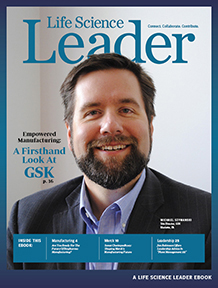Allergan, Biogen, And GSK — 3 Questions To 3 Manufacturing Experts At 3 Companies

By Rob Wright, Chief Editor, Life Science Leader
Follow Me On Twitter @RfwrightLSL

What’s Going To Be Big In Biopharma Manufacturing In 2018?
Roger Connor, president global manufacturing & supply, GSK: In pharma manufacturing, there are a couple of critical considerations in 2018: the impact of Brexit, digital transformation and delivering against regulator expectations. 2018 will be a pivotal year for UK pharmaceutical manufacturing in preparing for the impact of Brexit. The target is very clear — a secure source of medicines to patients throughout and after Brexit implementation. While the outcome of negotiations is far from certain, it is clear that any organization with UK or EU manufacturing will be impacted by these changes.
Companies that can deliver digital solutions in the supply chain and change their culture to adopt the new digital age will be the companies that win. To achieve this, Pharma companies should be partnering with technology providers and sharing opportunities within the sector that enable the industry as a whole to progress more quickly.
What Manufacturing Trends From Other Industries Will Begin To Spill Over Into Biopharmaceutical Manufacturing In 2018 And Beyond?
Paul McKenzie, Ph.D., EVP pharmaceutical operations & technology, Biogen: Many companies have used Big Data and analytics to change the nature of traditional customer-facing segments, and will increasingly be applying those strategies to R&D and manufacturing. Real-world evidence will continue to drive a value conversation around outcomes, which will in turn help companies better identify potential new drugs and quickly bring them to market. The companies that are successful will be ones figuring out how to use the full potential of this data to their advantage. Connecting our supply chains more virtually and replacing the fax machine transmittal of batch and lab activities is a must. Distribution models will also modernize as we learn from other industries successes.
What Region Other Than The U.S. Will Have The Biggest Impact On Biopharmaceutical Manufacturing In The Next 3 To 5 Years?
Wayne Swanton, EVP, Global Operations, Allergan: Western Europe has the industrial maturity, sophistication and access to talent that will continue to make it an attractive region for the biopharmaceutical industry to make strategic investments, particularly where there is heavy investment in technology. We see Western Europe taking a leadership role with the application of Process Analytical Technology and digitization. Clearly confidence in intellectual property protection and security of the supply chain continues to be a very important consideration. Having said that, market growth in the Asia-Pacific region is going to continue at a brisk rate, which will make it a natural location for many companies to consider when looking for future manufacturing locations with proximity to this expanding market and exploring potentially more favorable tax treatment. The region has made significant investments in biologics infrastructure recently and is projected to provide ~25 percent of global capacity over the next three to five years. Local manufacturing capabilities in emerging markets, with Brazil, Turkey, and China leading the way, have significantly advanced in recent years, although with a focus slanted more to enabling and expanding market access for generics and biosimilars and less on innovation.
